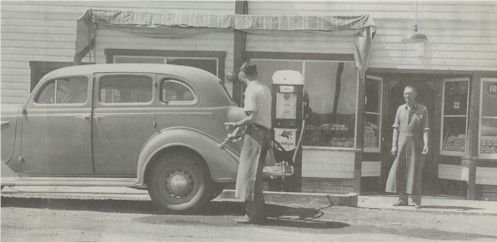Mom and Pop Shops
By Phyllis Badgley
"Patience is a virtue," as former proprietors of neighborhood
grocery stores can affirm. They developed patience while
penny-packing children stood before the candy counter making
decisions.
Depression-era children were bargain hunters, since nickels and
dimes were scarce.
In recent conversations with Verda Worsham Cahambers, we recalled
childhood days when a 10-cent spending spree was an exciting event.
She and her sister, Elda, lived in South Baker during the 1930s
where they skipped several blocks to Guyer's grocery store. Firmly
holding small coins in sweaty hands, big decisions had to be made at
the candy counter. They pondered whether their nickel would best be
spent for two jaw breakers, a tootsie roll, a sucker, or a
peppermint stick with a ring encircling it. Maybe two-for-a-penny
gum drops would last longer?
Even more difficult was the choice between Indian plug licorice or a
licorice pipe, useful when pretending to be Hawkshaw, the detective.
Guyer's Grocery, operated by patient proprietors George and Delia
Guyer, was a convenience hub for neighborhood families at a time
when three lumber mills operated in the South Baker area. Guyers
eventually sold to Charles and Grace Lewis, who developed patient
while owning the store for 10 years. The Joe DeGroote Grocery was
located nearby at the Y where Second Street branched.
Lumber mills played a major role in Baker's economy. I vividly
recall a nighttime fire at White Pine Mill, across the street from
these grocery stores. The Baker fire horn issued three blasts to
indicate a South Baker location. Townspeople rushed to see the
spectacle much like they did in recent years when Baker High School
burned.
Next morning at the millsite, a lone smokestack stood amid the
smoldering ruins. Fortunately, the mill was rebuilt and breadwinners
again employed.
Stepping back in time to Baker in the mid - 1920s, my parents, C. H.
"Red" and Louine May, established a small grocery store on 15th
Street, north of Broadway. Prior to that time my dad was employed at
Bill Warfel's Hub Grocery, Third and Broadway. Warfel's wife is
remembered as one of the donors of the rock collection the Oregon
Trail Regional Museum. Citing a need Warfel suggested that my
parents establish a grocery store in West Baker. They did so.
The front of our home was partitioned off, shelves built and
stocked. I was a small child, but recall peeking around the end of
the counter to view the customers. I was then that I first saw a
colored child. I was instantly fascinated and had to be hushed from
comment by my kind, understanding mother.
"Mom and Pop" grocery stores sprang up in various districts of Baker
to accommodate the immediate neighborhood. Some of those that came
into being at intervals were Rea's Grocery, corner of Fourth and
Carter streets; Elm Street Grocery, corner of Elm and Estes; Third
and Dewey Market near the underpass; and Shafner.

George Guyer, right was proprietor of
Guyer's Grocery at 600 Second street in
South Baker City. His son Randell Guyer Sr. pumped gas.
Printed here with the permission of
Baker City Herald
Sommer Building Has Quite A History In Baker City
By Phyllis Badgley
Do you remember Baker's Sommer Building? I do. It was a four story
building on the corner of Main and Washington, north across the
street from the Geiser Grand Hotel.
This brick structure housed business and professional offices in the
upper stories. An elevator (entrance on Washington Avenue) provided
access to doctor and lawyers quarters, Leland Heart was a longtime
elevator operator.
Some of the attorneys who practiced there were Hallock, Donald, and
Banta. The late David Silven joined the firm in mid-forties. Later,
the firm built offices across from the Courthouse, in the 1900 block
of Third Street, John Horton was associated with the firm at one
time. Presently it is known as Silven, Schmeits and Vaughan.
Several doctors had offices in the Sommer Building. Dr. Harry
Horton, dentist, was in practice there in the forties. Gary Dielman
said he remembers going to Dr. Horton in 1947 when he made his first
childhood visit to a dentist.
Drs. Roger and Flora Biswell had their medical practice in the
Sommer Building, before establishing offices on North Main Street.
Presently the offices of Guyer, Lindley, Bailey, and Martin are
located there.
The ground floor of the Sommer Building housed Grows Jewelry Store
(later Cate's). Ed Mineff's Geiser Grand Barber Ship was in the
adjoining portion of the building.
Mineff's shop was a successful five-chair establishment. He and
wife, Rose, chose to rear their family of three girls in Baker. One
daughter, Grace Lewis, remains here. She is a retired school teacher
and historian. Dorothe resides in Washington state. Helen is
deceased. The barber shop was later operated as Kofford and Dickison.
When U.S. Bank took over the location in 1960, the barber shop moved
north in the same block. Later, Robbins Arrow store was housed
there, and presently it's the home of Baker floral.
In mid-30s, in the rear portion of the Sommer Building, O.H.P.
McCord established an office where he dealt in contracts, loans, and
lock box rentals. I recall when my dad, with Red's Delivery and
Transfer, hauled a number of lock boxes from a source in Bend to be
put in McCord's office. He remarked at the time that the steel
safety boxes were among the heaviest loads he had encountered in his
years of service.
Lois Comstock was secretary at the McCord office for an extended
time. Robert McCord joined the firm and it was called McCord and
Son. It eventually moved to the 1800 block on Main Street. A gold
display and other Baker County artifacts were featured attractions
in the McCord office. Robert's wife, Neva, graciously presented our
local library with a fine collection of early-day photos from the
McCord collection.
The era of the Sommer building came to an end in 1960 when the
structure was razed to make room for the U.S. Bank (formerly known
as the First National.) The bank moved across Main Street to the
present location, 2000 Main St.,
Phyllis Badgley is a lifelong Baker City resident, historian and
writer.
Printed here with permission of Record Courier
